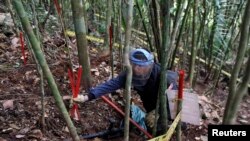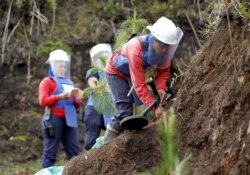Thirty-eight more Colombian municipalities are considered free of landmines and unexploded ordinance, President Ivan Duque said Tuesday, as civilian and military efforts to remove improvised explosives continue despite ongoing conflict in some areas.
Colombia was once among the countries where people suffered the most injuries from landmines, one result of more than five decades of armed conflict between leftist guerrillas, crime gangs, right-wing paramilitary groups and the government.
More than 700 of Colombia's 1,122 municipalities once had landmines, but 391 of those are now certified as mine-free.
"Today we make history because we are freeing 38 municipalities from suspicion of mines," Duque told attendees at a ceremony in the Andean country's southwest. "Thirty-eight municipalities have said goodbye to this tragedy; they have the light of new hope."
Mines, widely used by both rebels and crime gangs to impede military movements, have killed 2,297 people and injured another 9,492 since 1990, government figures show.
A 2016 peace deal with the Revolutionary Armed Forces of Colombia (FARC) rebels allowed de-mining work to accelerate in certain mountain and jungle areas which formerly had guerrilla presence, but remaining rebel group the National Liberation Army (ELN) and crime gangs continue to use improvised explosives, non-governmental organizations say.
Some 9.8 million square meters have been cleaned of mines and 7,100 explosive devices destroyed across the country of 48 million. The army and 11 civilian groups and NGOs, including the Halo Trust, are responsible for de-mining work.
Colombia, along with more than 160 other countries, is a signatory to the Ottawa Treaty, which forbids the manufacture, storage and use of landmines.
It has pledged to remove all mines by 2021 and will need to ask fellow signatories to approve an extension if it misses its removal target.






